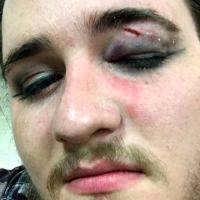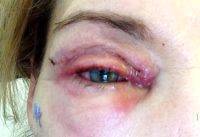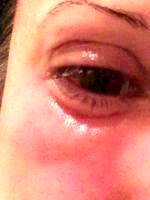Upper Blepharoplasty Complications
Upper eyelid surgery is very safe. It can be performed in the office under local anesthesia without any sedation or general anesthesia and typically takes about 30 minutes. With that said, the photos you submit show very youthful upper eyelids and a nice upper eyelid crease
You do have a slight asymmetry with excess upper eyelid skin in your right upper eyelid compared with your left but this is very subtle.
Risks of blepharoplasty
Blepharoplasty, as with any surgery, has complications, but the risks are very low if performed correctly with appropriate preoperative measures. The general risks are same as those for any dental procedure! The risk of blindness, specifically, are extremely rare; less than the risk of getting into major car accident!
An upper blepharoplasty can be done under local but if fat is removed medially it can be a bit uncomfortable under local only.
Upper Blepharoplasty Risks & Anesthesia
Although the risks of upper blepharoplasty, especially under local anesthesia, are very small, they do include blindness (though very much less so than lower blepharoplasty).
Risk Are Remote But Not Zero
All procedures have risks. Fortunately the risks are very low in skilled hands but still possible. The upper blepharoplasty procedure can be performed under local anesthesia safely and comfortably. Complications include bleeding, infection, unfavorable scarring, asymmetry, reoperation, dry eye symptoms, difficulty closing the eyes, lid drooping, corneal irritation, abrasion, eye injury and yes even blindness
Upper eyelid surgery in good hands is usually very safe,quick and easy. Like any surgery on rare occasion you can get an infection or bleeding. You can get a bad scar or asymmetry of results. Visual issues and difficulty closing the lids if overly resected are very rare. (Robert Savage, MD (retired), Wellesley Plastic Surgeon)

Complications Are Usually Mild And Transient
Revision Upper Blepharoplasty
It is important to understand that revision blepharoplasty can be challenging especially if too much skin or fat is removed, and can also increase the chance of dryness. This should be done in the hands of a Board Certified Plastic Surgeon or Oculoplastic with Expertise in Revision Cosmetic surgery. (Rod J. Rohrich, MD, Dallas Plastic Surgeon)
You have a nice and symmetric amount of eyelid show, with fullness of the lids which is a sign of youth. I don’t think you would see benefit at this time in your life and may even look less natural.
There is a high probability that any eyelid surgery will make your eyelids look unnatural. Make an appointment for in office consultation with an experienced eyelid surgeon for comprehensive evaluation.

Complications In Blepharoplasty Are Uncommon
You will need to have the blepharoplasty tailored to your specific situation. Usually the blephoraplasty is more conservative than what is done for older patients. (George Orloff, MD, FACS, Burbank Plastic Surgeon)
Upper eyelid blepharoplasty can be done under local anesthesia and does not require general anesthesia except for in specific cases. There are many risks that should be reviewed in detail with your surgeon prior to having surgery, especially around your eye

Complications In Blepharoplasty How To Avoid And Manage Them
Consult with a board certified Facial Plastic Surgeon for your specific circumstances.
Blepharoplasty complications and anesthesia
Blindness can occur from either upper or lower blepharoplasty but is exceedingly rare. We have never seen it in our practice in over 22 years. While you are able to have an upper blepharoplasty performed under local anesthesia, patients will have a conscious awareness of the procedure, and removal of the fat pads is painful
The fat pads do not numb up with local numbing medication and is why we usually perform these under general anesthesia.

Hematomas After Blepharoplasty Risk
Asymmetry post-op
You have quite a bit of inflammation still. The excess edema on the left may be pulling that lid down. It may also mean the muscle inside may be quite swollen and not working well yet.
Give it more time and as the swelling goes down, hopefully the left eye will lift. As the left lid elevates, the right will actually drop so they will be more even. If at 6 months you still have some ptosis on the left, you can correct it at that time. (John J. Martin, Jr., MD, Coral Gables Oculoplastic Surgeon)
At this point you are still very swollen and it is impossible to tell whether there was drooping or ptosis present before the surgery of the left eye. I would wait for the swelling to resolve and then evaluate. your left eyelid is lower and this may have been there preop and maybe you need ptosis repair as well.

How To Avoid Blepharoplasty Complication
Upper bleph post op asymmetry
Recovery time after eyelid surgery varies greatly between individuals. The upper eyelids heal very quickly but complete healing of the lower eyelids can take six weeks if the muscle and fat are treated.
the left eye appears to have some redness on the lid. make sure your doctor rules out any infection while you are healing. Swelling, discoloration, and some bruising are to be expected. It is not unusual to have some difficulty seeing during the first day or two after surgery because of the swelling and eye lubricants/ointment used during and after surgery. (Jed H. Horowitz, MD, FACS, Orange County Plastic Surgeon)

Low Complication Rate
It is common for both eyes to heal differently with one side having more swelling and/or bruising than the other. Be patient – you cannot assess the final lid height while you are swollen and bruised.
Sometimes a revision is necessary but this is not done until all swelling has resolved. It is too early to tell. If you have concerns share them with your surgeon! (Keshini Parbhu, MD, Orlando Oculoplastic Surgeon)
Keloids are very rare after blepharoplasty
The risk of keloid formation in the eyelid is very low; almost negligible. I have performed thousands of blepharoplasties and I have never had a patient develop a keloid. I think it is safe for you to proceed with blepharoplasty surgery
Keloid for eyelid surgery

Puffiness And Bruising After Blepharoplasty
Low risk of keloid with eyelid surgery
The risk of keloid formation following upper eyelid blepharoplasty is extremely low. However, if the incision on the inner (medial) portion of the eyelid extends too far towards the nose, it is possible to form a thick, raised, hypertrophic scar, possibly even a keloid in that area. I agree that it is very unlikely that you would develop a keloid in an upper eyelid blepharoplasty scar.
Keloids in eyelids
I concur. In thousands of blepharoplasty cases over 25 years I’ve never seen a patient left with a scar remotely resembling a keloid. The eyelid appears to be a priveliged site in this regard, and almost always heals with an undetectable scar

Surgery For Eyelids Picture Result With Doctor Narongdej Jiarapeepan
I have been told by board certified opthomologic cosmetic surgeons that eyelid skin does not keloid. Be sure your incisions stay coml;petely on the lid. I have never seen a lid keloid in 40 years
There is no substitute for a personal consultation.
Generally people who say this do not actually form keloids. What they may have is a scar on their torso that this wider than ideal. The scar may even be a little ropy in which case it is a hypertropic scar not a keloid
Keloid are unusual scars that grow beyond the confines of the actual wound. Scars on the body typically heal wider than ideal because of wound tension. This is much less an issue for the eyelid where there is very little wound tension
Little to no risk
In my training it was taght that eyelids do not form keloids. However, I have small keloids in 2 African-American patients who had very large reconstructive operations on their eyelids. But I have never seen it after any of the other several thousand eyelid operations including cosmetic blepharoplasty that I have performed
Fat grafting will help with lid hollows
When upper eyelid surgery is ‘overdone’ and the lid has become hollow, fat grafting is effective in reducing some of the damage. We don’t like artificial fillers, as they don’t behave in the same way in the eyelid.
Grafting can be done conservatively and in ‘layers’ to prevent compounding problems. The brow when lifted is very hard to get back down, a word of caution to others.

True Blepharoplasty Complications Are Rare In Experienced Hands
Stuffing grafted fat into a hollow upper eyelid suclus (i.e. fat grafting) is no an approach that has worked to fix these issues. Also each situation is unique. There is no approach to reconstruction where one size fits all.
There is no set price. WIthout an examination, it is impossible to know what you need. A photograph is helpful to understand how severe you issue is. There are post upper eyelid surgery circumstances that lend themselves to certain types of repairs that are more predictable than others.

An Experienced Eyelid Surgeon Will Understand How To Minimize Risks
Hollow eyes after blepahroplasty
You need a good evaluation to give a true assessment. You may want to consider a reversible filler such as Restylane before going to a potentially more permanent treatment such as fat. Fat grafting has many potential complications.
As you have already had a problem once – maybe filler is a better option. The first step is an evaluation by an experienced lid surgeon.
I would not recommend an upper lid belepharoplasty at this point .i would recommend that you consider a lower lid blepharoplasy with you anatomy and because you have failed filler success around the lower lid.
Some patient’s anatomy is such that surgical correction of the lower lid can be more precise and successful that the filler approach.i recommend a consult with a BOARD-CERTIFED PLASTIC SURGEON who regularly perform cosmetic eyelid surgery.
The doctor will examine your anatomy and them recommend a plan customized to correct your issues.
The filler that remains will take a long time to go away. In my practice- I remove the filler before surgery.
For young patients, I often recommend filler injections to the tear trough to mask puffiness. However, when that does not achieve the results we want, surgical lower blepharoplasty is a reasonable next step.
I’m not convinced you would benefit from upper blepharoplasty. Consider a second opinion with an Oculoplastic surgeon (eyelid specialist) to discuss your goals and concerns..
you do not have a lot of excess skin in the upper eyelid and only small amount in the lower eyelid. You can try undergoing laser treatments to tighten the skin in the upper and lower eyelids or try Thermismooth before you undergo any surgery.
